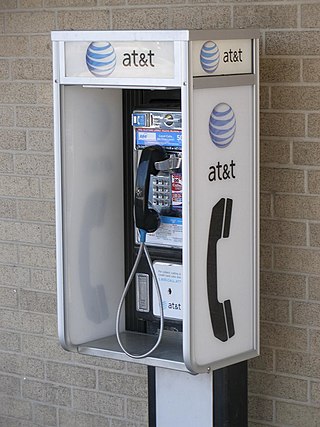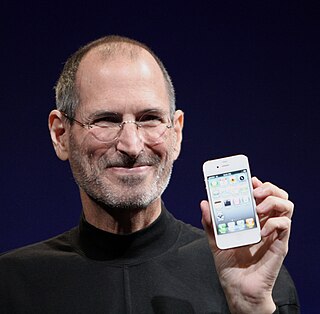
A telephone, colloquially referred to as a phone, is a telecommunications device that permits two or more users to conduct a conversation when they are too far apart to be easily heard directly. A telephone converts sound, typically and most efficiently the human voice, into electronic signals that are transmitted via cables and other communication channels to another telephone which reproduces the sound to the receiving user. The term is derived from Ancient Greek: τῆλε, romanized: tēle, lit. 'far' and φωνή, together meaning distant voice.
Caller identification is a telephone service, available in analog and digital telephone systems, including voice over IP (VoIP), that transmits a caller's telephone number to the called party's telephone equipment when the call is being set up. The caller ID service may include the transmission of a name associated with the calling telephone number, in a service called Calling Name Presentation (CNAM). The service was first defined in 1993 in International Telecommunication Union – Telecommunication Standardization Sector (ITU-T) Recommendation Q.731.3.

A payphone is typically a coin-operated public telephone, often located in a telephone booth or in high-traffic public areas. Prepayment is required by inserting coins or telephone tokens, swiping a credit or debit card, or using a telephone card.
A ringtone is the sound made by a telephone to indicate an incoming telephone call. Originally referring to the sound of electromechanical striking of bells or gongs, the term refers to any sound by any device alerting of an incoming call.

Jane Barbe was an American voice actress and singer. She was known as the "Time Lady" for the recordings she made for the Bell System and other phone companies. The ubiquity of her recordings eventually made her a pop-culture figure, and her death drew national attention.

An answering machine, answerphone, or message machine, also known as telephone messaging machine in the UK and some Commonwealth countries, ansaphone or ansafone, or telephone answering device (TAD), is used for answering telephone calls and recording callers' messages.
A voicemail system is a computer-based system that allows people to leave a recorded message when the recipient is unable to answer the phone. The caller is prompted to leave a message and the recipient can retrieve said message at a later time.

Antonio Santi Giuseppe Meucci was an Italian inventor and an associate of Giuseppe Garibaldi, a major political figure in the history of Italy. Meucci is best known for developing a voice-communication apparatus that several sources credit as the first telephone.
Call waiting is a telephone service where a subscriber can accept a second incoming telephone call by placing an in-progress call on hold—and may also switch between calls. With some providers it can be combined with additional features such as conferencing, call forwarding, and caller ID. Call waiting is intended to alleviate the need to have more than one telephone line or number for voice communications.
Call forwarding, or call diversion, is a telephony feature of all telephone switching systems which redirects a telephone call to another destination, which may be, for example, a mobile or another telephone number where the desired called party is available. Call forwarding was invented by Ernest J. Bonanno.
A pen register, or dialed number recorder (DNR), is a device that records all numbers called from a particular telephone line. The term has come to include any device or program that performs similar functions to an original pen register, including programs monitoring Internet communications.
Last-call return, automatic recall, or camp-on, is a telecommunication feature offered by telephony service providers to subscribers to provide the subscriber with the telephone number, and sometimes the time, of the last caller. The service may also offer the facility to place a call to the calling party.
Music on hold (MOH) is the business practice of playing recorded music to fill the silence that would be heard by telephone callers who have been placed on hold. It is especially common in situations involving customer service.

The invention of the telephone was the culmination of work done by more than one individual, and led to an array of lawsuits relating to the patent claims of several individuals and numerous companies. Notable people including in this were Antonio Meucci, Elisha Gray and Alexander Graham Bell.
Audichron Company was a company founded in the 1930s by John Franklin in Doraville, Georgia, to produce the Audichron, a talking clock. By the 1970s, there were thousands of Audichron time-of-day announcers in use all over the world. Audichron had also developed a machine to announce the temperature. During the 1970s and 1980s, Audichron began to manufacture other kinds of equipment besides time and temperature machines.

Phone sex is a conversation between two or more people by means of the telephone which is sexually explicit and is intended to provoke sexual arousal in one or more participants. As a practice between individuals temporarily separated, it is as old as dial telephones, on which no operator could eavesdrop. In the later 20th century businesses emerged offering, for a fee, sexual conversations with a phone sex worker.
Ronald A. Katz is an inventor and president of Ronald A. Katz Technology Licensing LP. His inventions are primarily in the field of automated call center technology. Katz has developed a portfolio of more than 50 US patents covering his innovations. His inventions are related to toll free numbers, automated attendant, automated call distribution, voice response unit, computer telephone integration and speech recognition. As a philanthropist and Ronald Reagan UCLA Medical Center board member, Ronald Katz helped launch UCLA Operation Mend. He is a son of musician and comedian Mickey Katz, the brother of Academy Award-winning actor Joel Grey, and uncle to actress and Dirty Dancing star Jennifer Grey.

The history of the iPhone development by Apple Inc. spans from the early 2000s to about 2010. The first iPhone was released in 2007. By the end of 2009, iPhone models had been released in all major markets.

Nextel Communications, Inc. was an American wireless service operator that merged with and ceased to exist as a subsidiary of Sprint Corporation, which would later be bought by T-Mobile US and folded into that company. Nextel in Brazil, and formerly in Argentina, Chile, Peru, the Philippines, and Mexico, is part of NII Holdings, a stand-alone, publicly traded company not owned by Sprint Corporation.
A sound trademark, sound logo, or audio logo is a trademark where sound is used to perform the trademark function of uniquely identifying the commercial origin of products or services.











